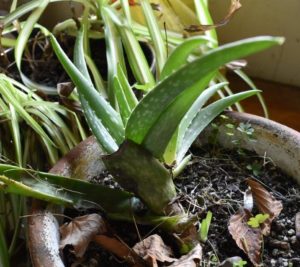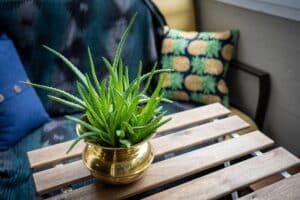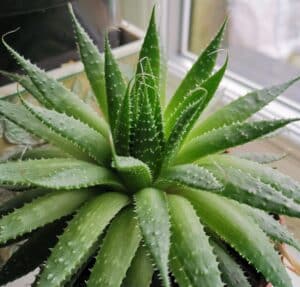Hello fellow readers, Long ago, I was given an Aloe Vera plant from a kind client who asked if I’d take the pot of aloes hidden in the corner of her sunroom, apologetically confessing to neglecting them. “I know how that goes,” I consoled, “it’s hard to know what to do when plants become overgrown.” Which leads to a story about rescuing the Aloe plants that help heal.
Always quarantine new or hand-me-down plants.
The trio of Aloes was rootbound as the plastic pot was severely bulging. That’s an easy fix, but with severely yellowed foliage, the plants looked beyond saving. I always place new or hand-me-down plants away from others to be sure no critters or diseases come for a ride. It was early summer, so I quarantined the trio outside in a part-shady spot. That way, they could absorb the nitrogen benefits of rain.
Several weeks went by, and the plants looked hopelessly unchanged. So, I wrestled them out of the pot and tossed them onto the compost pile, feeling sadness for the neglect they endured.
A few weeks later, with their roots exposed on the heap, I noticed their leaves began greening up! I gathered the throwaways and potted them using a sandy soil mix. Their recovery was rapid, and they quickly grew into two-foot-wide plants.
The benefits of Aloe plants
Most know about the benefits of using the gel-like insides of Aloe leaves to soothe burns, itchy rashes, and insect bites. There are articles about Aloe plants’ anti-anxiety benefits and air-purifying attributes—suggesting you place them in your bedroom where they can have indirect sun daily. They are said to lower carbon dioxide levels and remove formaldehyde and benzene, found in cleaners and paints, from the air.

My recovering toppled-over Aloe
Years later, the rescued aloes grew top-heavy. One toppled over and broke into “pieces-parts,” as Mom would say. I brought the fleshy stems to the salon I occasionally visit to tidy up my garden-worn nails and cracking cuticles. The manicurists use the gooey gel as a hand cream.

Aloe Photo by Alexandra Tran on Unsplash
Rather than toss the roots left after the crash, I tucked the pot amongst other plants outside after the risk of frost. A few months later, new shoots emerged, and I watched and marveled as it grew into a bouncing baby plant.
The remaining plants became a balancing act. Other than cutting off lower leaves as they age to lighten the load —I did that, which left the long stem and heavy top— I couldn’t find any solution. Nor could other parents of aloes looking for an answer on garden Q & A sites. And so, it seemed best to harvest and share all the leaves with others.
The Mystery of the Aloe Going to Mush
There’s an update on the toppled plant that grew to be glorious. Mysteriously, it went through a swift and sudden demise soon after Thanksgiving when Gene, my friend that recently joined the angels, visited. I’m so grateful for that time.

Aloe Photo by Jude Smart on Unsplash
We don’t have a guest room, so I modified the office for him to stay. We were amid a cold spell, and Gene is used to heat. I moved the portable electric fireplace into the office and placed the aloe plant on the top (the surface of the faux fireplace does not get hot.) Gene toasted the room to 80 degrees from my regular 65 by day and 63 at night. Of course, an electric heater dries the air. Perhaps that was the culprit that caused the stems one by one to turn to mush. But Aloes like dry air, with humidity between 20-30 percent, unlike most houseplants.
Aloes can go to mush, like other succulents, when you overwater them, which is not the case using a nifty water meter. So I wonder if the sudden shift and temperature stressed the plants, which is likely so. They don’t like drafts or rapid changes in their environment.
The Aloe taught me not to give up.
Maybe the fertilizer I used when the Aloe started to decline had an impact. Salts in fertilizers can damage plant tissue, so it’s best to water your indoor plants and then water them again with the fertilizer within the next few days to prevent root burn. I skipped that step.
Or maybe it was just time for it to go. It had a good life for years and taught me not to give up on failing plants or when circumstances decline, for that matter. There is always hope. But when it’s time to go, take comfort in knowing everything returns to our source, nourishing the next generations, just like we leave behind the love we give.
Garden Dilemmas? AskMaryStone@gmail.com or your favorite Podcast App.
There’s more to the story in the Garden Dilemmas Podcast:
Benefits of Watering with Rainwater
The story featuring my friend Gene – A Magical Blessing Moth
The Old Farmer’s Almanac: Aloe Vera Plant Care: How to Take Care of Aloe Vera


